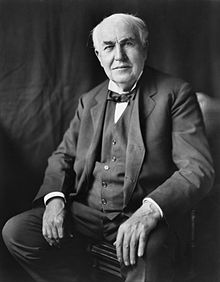Thomas Alva Edison (February 11, 1847 – October 18, 1931) was an American inventor and businessman.[1][2][3] He developed many devices in fields such as electric power generation, mass communication, sound recording, and motion pictures.[4] These inventions, which include the phonograph, the motion picture camera, and early versions of the electric light bulb, have had a widespread impact on the modern industrialized world.[5] He was one of the first inventors to apply the principles of organized science and teamwork to the process of invention, working with many researchers and employees. He established the first industrial research laboratory.[6]
Edison was raised in the American Midwest. Early in his career he worked as a telegraph operator, which inspired some of his earliest inventions.[4] In 1876, he established his first laboratory facility in Menlo Park, New Jersey, where many of his early inventions were developed. He later established a botanical laboratory in Fort Myers, Florida, in collaboration with businessmen Henry Ford and Harvey S. Firestone, and a laboratory in West Orange, New Jersey, that featured the world's first film studio, the Black Maria. With 1,093 US patents in his name, as well as patents in other countries, Edison is regarded as the most prolific inventor in American history.[7] Edison married twice and fathered six children. He died in 1931 due to complications from diabetes.
- ^ Adrian Wooldridge (September 15, 2016). "The alphabet of success". The Economist. Archived from the original on September 16, 2016. Retrieved September 16, 2016.
- ^ Sproule, Anna (2000). Thomas Alva Edison: The World's Greatest Inventor (1st U.S. ed.). Woodbridge, CT: Blackbirch Press. ISBN 978-1-56711-331-0.
- ^ "Hangout – Thomas Edison". state.nj.us. State of New Jersey.
- ^ a b "Con Edison: A Brief History of Con Edison – electricity". Coned.com. January 1, 1998. Archived from the original on October 30, 2012. Retrieved October 11, 2012.
- ^ "The Wizard of Menlo Park". The Franklin Institute. Archived from the original on March 5, 2013. Retrieved February 24, 2013.
- ^ Walsh, Bryan (July 15, 2009). "The Electrifying Edison". Time. Archived from the original on July 18, 2009. Retrieved December 31, 2013.
- ^ Boyer, Paul S., ed. (2001). The Oxford Companion to United States History. Oxford University Press. p. 211. ISBN 978-0-19-989109-2. OCLC 57680178.
